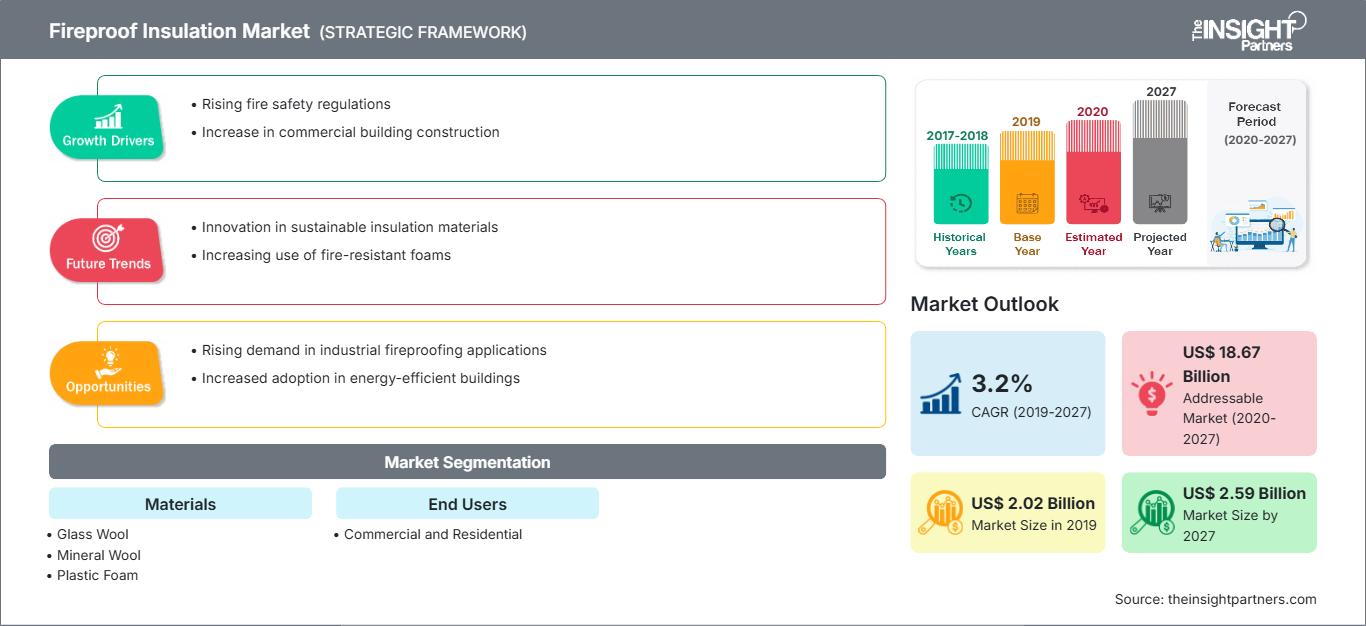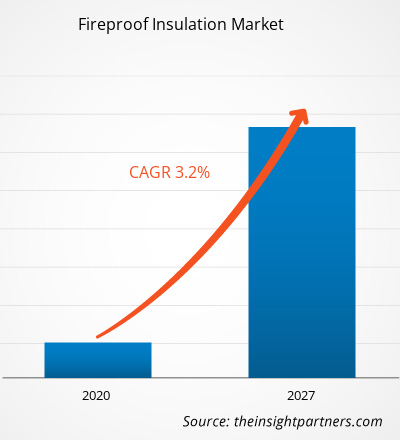[Rapporto di ricerca]Il mercato dell'isolamento ignifugo è stato valutato a 2,02 miliardi di dollari nel 2019 e si prevede che raggiungerà i 2,59 miliardi di dollari entro il 2027; si prevede una crescita a un CAGR del 3,2% nel periodo di previsione 2020-2027.
I materiali isolanti ignifughi contribuiscono a ridurre i danni causati dal fuoco. I materiali isolanti ignifughi sono disponibili in cinque forme: schiuma, fibre tritate, pannelli o blocchi isolanti, materassini fibrosi e tessuti, pellicole e fogli. La resistenza di ciascuna forma dipende dal materiale di cui è composta. La domanda di prodotti isolanti ignifughi è elevata nel settore residenziale a causa dei rigorosi standard edilizi relativi alla protezione antincendio e della crescente attività di edilizia residenziale. Tuttavia, la popolarità dell'isolamento ignifugo sta crescendo significativamente nel settore commerciale a causa della crescente attenzione alla sicurezza antincendio. Inoltre, le attività di costruzione e ristrutturazione stanno crescendo in modo significativo sia nelle economie sviluppate che in quelle in via di sviluppo, il che dovrebbe avere un impatto positivo sul mercato dell'isolamento ignifugo.
Si prevede che il mercato dell'isolamento ignifugo nell'area APAC crescerà al CAGR più elevato durante il periodo di previsione. La crescita del mercato in questa regione è principalmente attribuibile all'elevata popolazione, che ha generato un'elevata domanda di edilizia commerciale e residenziale. Inoltre, la crescita delle attività di edilizia commerciale nell'area MEA sta generando una crescente domanda di isolamento ignifugo nella regione. Ad esempio, la regione ospiterà l'Expo di Dubai 2020, la Coppa del Mondo FIFA 2022 in Qatar, il Mar Rosso e Neom e Al Qiddiya in Arabia Saudita. La costruzione dei progetti sopra menzionati comporta strutture di grandi dimensioni e richiede standard di sicurezza notevolmente elevati. Tuttavia, il Sud America ha registrato un tasso di crescita lento nel corso degli anni e si prevede che il mercato dell'isolamento ignifugo crescerà a un ritmo lento nella regione.
Personalizza questo rapporto in base alle tue esigenze
Potrai personalizzare gratuitamente qualsiasi rapporto, comprese parti di questo rapporto, o analisi a livello di paese, pacchetto dati Excel, oltre a usufruire di grandi offerte e sconti per start-up e università
Mercato dell'isolamento ignifugo: Approfondimenti strategici

-
Ottieni le principali tendenze chiave del mercato di questo rapporto.Questo campione GRATUITO includerà l'analisi dei dati, che vanno dalle tendenze di mercato alle stime e alle previsioni.
L'epidemia di COVID-19 ha un impatto negativo sulle economie e sui settori industriali di diversi paesi a causa di lockdown, divieti di viaggio e chiusure aziendali. I settori chimico e dei materiali sono tra i principali che hanno subito gravi interruzioni, come restrizioni alla catena di approvvigionamento e chiusura degli impianti di produzione. La chiusura di diversi impianti e fabbriche in diversi paesi interrompe le catene di approvvigionamento globali e ha un impatto negativo sulle attività di produzione, sui tempi di consegna e sulle vendite di beni di vario tipo. Diverse aziende hanno già annunciato possibili ritardi nelle consegne dei prodotti e un crollo delle vendite future. Inoltre, i divieti di viaggio globali imposti da paesi in Europa, Asia e Nord America stanno ostacolando la collaborazione commerciale e le opportunità di partnership. Pertanto, questi fattori stanno frenando la crescita del mercato dell'isolamento ignifugo nel settore chimico e dei materiali.
Approfondimenti di mercato: la crescente domanda di materiali isolanti a risparmio energetico per ridurre le emissioni di gas serra dovrebbe alimentare la crescita del mercato dell'isolamento ignifugo
La funzione principale dell'isolamento è controllare e regolare il flusso di calore all'interno e all'esterno della casa. Le soluzioni a risparmio energetico contribuiscono ad aumentare l'efficienza energetica nelle aziende e nelle abitazioni, risparmiando denaro. Diversi tipi di soluzioni a risparmio energetico sono ampiamente utilizzati nei settori residenziale e industriale, contribuendo a loro volta alla riduzione delle emissioni di gas serra. L'installazione di un isolamento si traduce in una notevole riduzione degli sprechi energetici e dell'importo della bolletta. I materiali isolanti, come la schiuma, svolgono un ruolo significativo nell'isolamento degli edifici. Riempiono le fessure che possono potenzialmente causare perdite d'aria e creano un ambiente efficiente dal punto di vista energetico all'interno di un edificio. Grazie alle sue efficaci e potenti proprietà isolanti, la schiuma spray attrae investimenti da parte dei clienti per proteggere le loro proprietà in caso di incendio. L'isolamento in schiuma poliuretanica spray è un altro tipo di schiuma utilizzata per riempire e isolare grandi vuoti e superfici. Questo materiale contribuisce a migliorare la qualità dell'aria interna e riduce i costi di riscaldamento e raffreddamento, diminuendo al contempo il consumo energetico. Aziende come ROCKWOOL International A/S, John Manville, Knauf Insulation GmbH e InSoFast, LLC forniscono isolamento ignifugo.
Approfondimenti sui materiali
In base al materiale, il mercato dell'isolamento ignifugo si divide in lana di vetro, lana minerale, schiuma plastica, fibra di vetro, schiuma poliuretanica e altri. Il segmento della lana di vetro ha rappresentato una quota di mercato maggiore nel 2019. La lana di vetro è realizzata con vetro riciclato e sabbia fusa, come carbonato di sodio, calcare e sabbia, che aiuta a intrappolare l'aria e bloccare calore, rumore e freddo. Questa proprietà di questo materiale è caratterizzata da leggerezza, resistenza ai parassiti e flessibilità, che lo rendono ampiamente utilizzato per l'isolamento elettrico e termico negli edifici. Il materiale viene steso in soffitta per bilanciare la temperatura all'interno dell'edificio. La lana di vetro assorbe l'energia sonora e viene utilizzata per migliorare le prestazioni acustiche di soffitti, pareti, tetti e pavimenti. La fibra di lana di vetro è incombustibile e viene quindi utilizzata come isolante acustico o termico. Poiché questo materiale è realizzato con materiali riciclati, tra cui vetro, scorie e altri sottoprodotti industriali, offre una maggiore sostenibilità.
Consigli per l'utente finale
In base all'utente finale, il mercato dell'isolamento ignifugo è segmentato in residenziale e commerciale. Il segmento residenziale ha rappresentato la quota di mercato maggiore nel 2019. Il numero di progetti di costruzione nel settore residenziale sta aumentando a un ritmo esponenziale in economie come Cina, India, Filippine, Polonia e Russia. Durante la costruzione di case, vengono utilizzati diversi tipi di isolamento, tra cui l'isolamento ignifugo. A volte i proprietari di casa installano materiali e materassini in loco in base alle esigenze, mentre altri tipi di isolamento richiedono l'installazione di un professionista. Nell'edilizia residenziale, i pannelli in schiuma vengono installati principalmente sul lato interno delle pareti nelle case esistenti e sul lato esterno delle pareti nelle nuove costruzioni. L'isolamento è un componente essenziale utilizzato nelle abitazioni per ridurre il consumo energetico. Utilizzando materiali isolanti, i proprietari di casa possono risparmiare in media il 15% sui costi di riscaldamento e raffreddamento e l'11% sui costi energetici totali. Secondo la North American Insulation Manufacturers Association, negli Stati Uniti oltre il 70% delle case unifamiliari presenta un isolamento termico insufficiente. Questo aspetto contribuirebbe ad aumentare l'utilizzo dell'isolamento nelle proprietà residenziali. Materassini in fibra, lana minerale e fibra di vetro sono tra i principali materiali isolanti ampiamente utilizzati nel settore residenziale.
Alcuni attori che operano nel mercato dell'isolamento ignifugo sono Saint Gobain SA, BASF SE, Johns Manville, Kingspan Group PLC, Lloyd Insulations (India) Limited, Owens Corning, ROCKWOOL International A/S, UP Twiga Fiberglass Limited, Knauf Insulation GmbH e L'ISOLANTE K-FLEX SPA, tra molti altri. Le aziende chiave implementano fusioni e acquisizioni e strategie di ricerca e sviluppo per espandere la base clienti e acquisire una quota significativa nel mercato globale, il che consente loro anche di mantenere il proprio marchio a livello globale.
In evidenza nel rapporto
- Tendenze progressive del settore nel mercato dell'isolamento ignifugo per aiutare gli operatori a sviluppare strategie efficaci a lungo termine
- Strategie di crescita aziendale adottate dai mercati sviluppati e in via di sviluppo
- Analisi quantitativa del mercato dell'isolamento ignifugo dal 2019 al 2027
- Stima della domanda globale di isolamento ignifugo
- Analisi PEST per illustrare l'efficacia di acquirenti e fornitori che operano nel settore
- Sviluppi recenti per comprendere lo scenario competitivo del mercato
- Tendenze e prospettive di mercato, nonché fattori che guidano e frenano la crescita del mercato dell'isolamento ignifugo
- Assistenza nel processo decisionale evidenziando le strategie di mercato che sostengono l'interesse commerciale, portando alla crescita del mercato
- Dimensioni del mercato dell'isolamento ignifugo in vari nodi
- Panoramica dettagliata e segmentazione del mercato, nonché dinamiche del settore dell'isolamento ignifugo
- Dimensioni del mercato dell'isolamento ignifugo in varie regioni con promettenti opportunità di crescita
Approfondimenti regionali sul mercato dell'isolamento ignifugo
Le tendenze regionali e i fattori che influenzano il mercato dell'isolamento ignifugo durante il periodo di previsione sono stati ampiamente spiegati dagli analisti di The Insight Partners. Questa sezione illustra anche i segmenti e la distribuzione geografica del mercato dell'isolamento ignifugo in Nord America, Europa, Asia-Pacifico, Medio Oriente e Africa, America Meridionale e Centrale.
Ambito del rapporto di mercato sull'isolamento ignifugo
| Attributo del rapporto | Dettagli |
|---|---|
| Dimensioni del mercato in 2019 | US$ 2.02 Billion |
| Dimensioni del mercato per 2027 | US$ 2.59 Billion |
| CAGR globale (2019 - 2027) | 3.2% |
| Dati storici | 2017-2018 |
| Periodo di previsione | 2020-2027 |
| Segmenti coperti |
By Materiali
|
| Regioni e paesi coperti |
Nord America
|
| Leader di mercato e profili aziendali chiave |
|
Densità degli operatori del mercato dell'isolamento ignifugo: comprendere il suo impatto sulle dinamiche aziendali
Il mercato dell'isolamento ignifugo è in rapida crescita, trainato dalla crescente domanda degli utenti finali, dovuta a fattori quali l'evoluzione delle preferenze dei consumatori, i progressi tecnologici e una maggiore consapevolezza dei vantaggi del prodotto. Con l'aumento della domanda, le aziende stanno ampliando la propria offerta, innovando per soddisfare le esigenze dei consumatori e sfruttando le tendenze emergenti, alimentando ulteriormente la crescita del mercato.

- Ottieni il Mercato dell'isolamento ignifugo Panoramica dei principali attori chiave
- Lana di vetro
- Lana minerale
- Schiuma di plastica
- Fibra di vetro
- Schiuma di poliuretano
- Altri
Mercato dell'isolamento ignifugo - dall'utente finale
- Residenziale
- Commerciale
Profili aziendali
- Saint Gobain SA
- BASF SE
- Johns Manville
- Kingspan Group PLC
- Lloyd Insulations (India) Limited
- Owens Corning
- ROCKWOOL International A/S
- UP Twiga Fiberglass Limited
- Knauf Insulation GmbH
- L'ISOLANTE K-FLEX SPA
- Analisi storica (2 anni), anno base, previsione (7 anni) con CAGR
- Analisi PEST e SWOT
- Valore/volume delle dimensioni del mercato - Globale, Regionale, Nazionale
- Industria e panorama competitivo
- Set di dati Excel
Report recenti
Rapporti correlati
Testimonianze
Motivo dell'acquisto
- Processo decisionale informato
- Comprensione delle dinamiche di mercato
- Analisi competitiva
- Analisi dei clienti
- Previsioni di mercato
- Mitigazione del rischio
- Pianificazione strategica
- Giustificazione degli investimenti
- Identificazione dei mercati emergenti
- Miglioramento delle strategie di marketing
- Aumento dell'efficienza operativa
- Allineamento alle tendenze normative






















 Ottieni un campione gratuito per - Mercato dell'isolamento ignifugo
Ottieni un campione gratuito per - Mercato dell'isolamento ignifugo